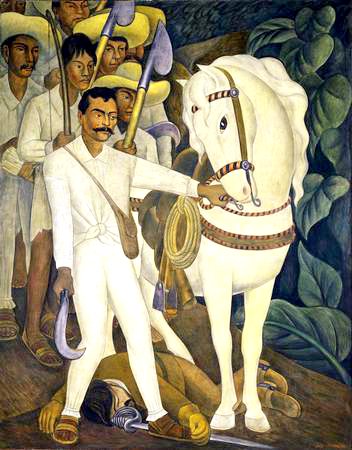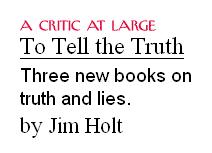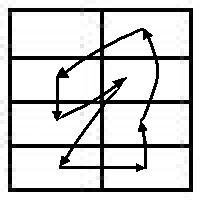” There is a pleasantly discursive treatment
of Pontius Pilate’s unanswered question
‘What is truth?’ ”
— Coxeter, 1987, introduction to Trudeau’s
The Non-Euclidean Revolution
” There is a pleasantly discursive treatment
of Pontius Pilate’s unanswered question
‘What is truth?’ ”
— Coxeter, 1987, introduction to Trudeau’s
The Non-Euclidean Revolution
"There is a pleasantly discursive treatment of
Pontius Pilate's unanswered question 'What is truth?'"
— H. S. M. Coxeter, 1987
Returning to the Walpurgisnacht posts
Decomposition (continued) and
Decomposition– Part III —
Some further background…
SAT
(Not a Scholastic Aptitude Test)
"In computer science, satisfiability (often written
in all capitals or abbreviated SAT) is the problem
of determining if the variables of a given Boolean
formula can be assigned in such a way as to
make the formula evaluate to TRUE."
— Wikipedia article Boolean satisfiability problem
For the relationship of logic decomposition to SAT,
see (for instance) these topics in the introduction to—
Advanced Techniques in Logic Synthesis,
Optimizations and Applications* —
Click image for a synopsis.
* Edited by Sunil P. Khatri and Kanupriya Gulati
Last night's post was about a talk last year at the annual student symposium of the ACCA (Associated Colleges of the Chicago Area), a group of largely Christian colleges.
The fact that the talk was by a student from Benedictine University suggests a review of the Urbi et Orbi speech by Pope Benedict XVI on Christmas 2010.
“The Word became flesh”. The light of this truth is revealed to those who receive it in faith, for it is a mystery of love. Only those who are open to love are enveloped in the light of Christmas. So it was on that night in Bethlehem, and so it is today. The Incarnation of the Son of God is an event which occurred within history, while at the same time transcending history. In the night of the world a new light was kindled, one which lets itself be seen by the simple eyes of faith, by the meek and humble hearts of those who await the Saviour. If the truth were a mere mathematical formula, in some sense it would impose itself by its own power. But if Truth is Love, it calls for faith, for the “yes” of our hearts.
And what do our hearts, in effect, seek, if not a Truth which is also Love? Children seek it with their questions, so disarming and stimulating; young people seek it in their eagerness to discover the deepest meaning of their life; adults seek it in order to guide and sustain their commitments in the family and the workplace; the elderly seek it in order to grant completion to their earthly existence.
The above excerpt from the Pope's speech may be regarded as part of a continuing commentary on the following remark—
There is a pleasantly discursive treatment of Pontius Pilate's unanswered question "What is truth?" — H. S. M. Coxeter, 1987
Truth, Geometry, Algebra
The following notes are related to A Simple Reflection Group of Order 168.
1. According to H.S.M. Coxeter and Richard J. Trudeau
“There is a pleasantly discursive treatment of Pontius Pilate’s unanswered question ‘What is truth?’.”
— Coxeter, 1987, introduction to Trudeau’s The Non-Euclidean Revolution
1.1 Trudeau’s Diamond Theory of Truth
1.2 Trudeau’s Story Theory of Truth
2. According to Alexandre Borovik and Steven H. Cullinane
2.1 Coxeter Theory according to Borovik
2.1.1 The Geometry–
Mirror Systems in Coxeter Theory
2.1.2 The Algebra–
Coxeter Languages in Coxeter Theory
2.2 Diamond Theory according to Cullinane
2.2.1 The Geometry–
Examples: Eightfold Cube and Solomon’s Cube
2.2.2 The Algebra–
Examples: Cullinane and (rather indirectly related) Gerhard Grams
Summary of the story thus far:
Diamond theory and Coxeter theory are to some extent analogous– both deal with reflection groups and both have a visual (i.e., geometric) side and a verbal (i.e., algebraic) side. Coxeter theory is of course highly developed on both sides. Diamond theory is, on the geometric side, currently restricted to examples in at most three Euclidean (and six binary) dimensions. On the algebraic side, it is woefully underdeveloped. For material related to the algebraic side, search the Web for generators+relations+”characteristic two” (or “2“) and for generators+relations+”GF(2)”. (This last search is the source of the Grams reference in 2.2.2 above.)
| This journal on October 8, 2008, at noon: “There is a pleasantly discursive treatment of Pontius Pilate’s unanswered question ‘What is truth?'” Trudeau’s 1987 book uses the phrase “diamond theory” to denote the philosophical theory, common since Plato and Euclid, that there exist truths (which Trudeau calls “diamonds”) that are certain and eternal– for instance, the truth in Euclidean geometry that the sum of a triangle’s angles is 180 degrees. Insidehighered.com onthe same day, October 8, 2008, at 12:45 PM EDT “Future readers may consider Updike our era’s Mozart; Mozart was once written off as a too-prolific composer of ‘charming nothings,’ and some speak of Updike that way.” — Comment by BPJ |
Updike died on January 27.
On the same date,
Mozart was born.
Requiem
| Mr. Best entered, tall, young, mild, light. He bore in his hand with grace a notebook, new, large, clean, bright. — James Joyce, Ulysses, |
Serious Numbers
A Yom Kippur
Meditation
"When times are mysterious
Serious numbers
Will always be heard."
— Paul Simon,
"When Numbers Get Serious"
"There is a pleasantly discursive treatment of Pontius Pilate's unanswered question 'What is truth?'"
— H. S. M. Coxeter, introduction to Richard J. Trudeau's remarks on the "story theory" of truth as opposed to the "diamond theory" of truth in The Non-Euclidean Revolution
Trudeau's 1987 book uses the phrase "diamond theory" to denote the philosophical theory, common since Plato and Euclid, that there exist truths (which Trudeau calls "diamonds") that are certain and eternal– for instance, the truth in Euclidean geometry that the sum of a triangle's angles is 180 degrees. As the excerpt below shows, Trudeau prefers what he calls the "story theory" of truth–
"There are no diamonds. People make up stories about what they experience. Stories that catch on are called 'true.'"
(By the way, the phrase "diamond theory" was used earlier, in 1976, as the title of a monograph on geometry of which Coxeter was aware.)

What does this have to do with numbers?
Pilate's skeptical tone suggests he may have shared a certain confusion about geometric truth with thinkers like Trudeau and the slave boy in Plato's Meno. Truth in a different part of mathematics– elementary arithmetic– is perhaps more easily understood, although even there, the existence of what might be called "non-Euclidean number theory"– i.e., arithmetic over finite fields, in which 1+1 can equal zero– might prove baffling to thinkers like Trudeau.
Trudeau's book exhibits, though it does not discuss, a less confusing use of numbers– to mark the location of pages. For some philosophical background on this version of numerical truth that may be of interest to devotees of the Semitic religions on this evening's High Holiday, see Zen and Language Games.
For uses of numbers that are more confusing, see– for instance– the new website The Daily Beast and the old website Story Theory and the Number of the Beast.
“There is a pleasantly discursive treatment
of Pontius Pilate’s unanswered question
‘What is truth?'”
— H. S. M. Coxeter, 1987, introduction to
Richard J. Trudeau’s remarks on
the “Story Theory” of truth
as opposed to
the “Diamond Theory” of truth
in The Non-Euclidean Revolution
A Serious Position
“‘Teitelbaum,’ in German,
is ‘date palm.'”
— Generations, Jan. 2003
“In Hasidism, a mystical brand
of Orthodox Judaism, the grand rabbi
is revered as a kinglike link to God….”
— Today’s New York Times obituary
of Rabbi Moses Teitelbaum,
who died on April 24, 2006
(Easter Monday in the
Orthodox Church)
From Wikipedia, an unsigned story:
“In 1923 Alfred Teitelbaum and his brother Wacław changed their surnames to Tarski, a name they invented because it sounded very Polish, was simple to spell and pronounce, and was unused. (Years later, he met another Alfred Tarski in northern California.) The Tarski brothers also converted to Roman Catholicism, the national religion of the Poles. Alfred did so, even though he was an avowed atheist, because he was about to finish his Ph.D. and correctly anticipated that it would be difficult for a Jew to obtain a serious position in the new Polish university system.”

“There is a pleasantly discursive treatment of Pontius Pilate’s unanswered question ‘What is truth?'”
— H. S. M. Coxeter, 1987, introduction to Richard J. Trudeau’s remarks on the “Story Theory” of truth as opposed to the “Diamond Theory” of truth in The Non-Euclidean Revolution
“A new epistemology is emerging to replace the Diamond Theory of truth. I will call it the ‘Story Theory’ of truth: There are no diamonds. People make up stories about what they experience. Stories that catch on are called ‘true.’ The Story Theory of truth is itself a story that is catching on. It is being told and retold, with increasing frequency, by thinkers of many stripes*….”
— Richard J. Trudeau in
The Non-Euclidean Revolution
“‘Deniers’ of truth… insist that each of us is trapped in his own point of view; we make up stories about the world and, in an exercise of power, try to impose them on others.”
— Jim Holt in The New Yorker.
(Click on the box below.)
Exercise of Power:
Show that a white horse–

a figure not unlike the
symbol of the mathematics
publisher Springer–
is traced, within a naturally
arranged rectangular array of
polynomials, by the powers of x
modulo a polynomial
irreducible over a Galois field.
This horse, or chess knight–
“Springer,” in German–
plays a role in “Diamond Theory”
(a phrase used in finite geometry
in 1976, some years before its use
by Trudeau in the above book).
Related material
On this date:
In 1490, The White Knight
(Tirant lo Blanc  )–
)–
a major influence on Cervantes–
was published, and in 1910

the Mexican Revolution began.
Illustration:
Zapata by Diego Rivera,
Museum of Modern Art,
New York
“First published in the Catalan language in Valencia in 1490…. Reviewing the first modern Spanish translation in 1969 (Franco had ruthlessly suppressed the Catalan language and literature), Mario Vargas Llosa hailed the epic’s author as ‘the first of that lineage of God-supplanters– Fielding, Balzac, Dickens, Flaubert, Tolstoy, Joyce, Faulkner– who try to create in their novels an all-encompassing reality.'”
Mathematics and Narrative
continued
"There is a pleasantly discursive treatment of Pontius Pilate's unanswered question 'What is truth?'"
— H. S. M. Coxeter, 1987, introduction to Richard J. Trudeau's remarks on the "Story Theory" of truth as opposed to the "Diamond Theory" of truth " in The Non-Euclidean Revolution
"I had an epiphany: I thought 'Oh my God, this is it! People are talking about elliptic curves and of course they think they are talking mathematics. But are they really? Or are they talking about stories?'"
— An organizer of last month's "Mathematics and Narrative" conference
"A new epistemology is emerging to replace the Diamond Theory of truth. I will call it the 'Story Theory' of truth: There are no diamonds. People make up stories about what they experience. Stories that catch on are called 'true.' The Story Theory of truth is itself a story that is catching on. It is being told and retold, with increasing frequency, by thinkers of many stripes*…."
— Richard J. Trudeau in The Non-Euclidean Revolution
"'Deniers' of truth… insist that each of us is trapped in his own point of view; we make up stories about the world and, in an exercise of power, try to impose them on others."
— Jim Holt in this week's New Yorker magazine. Click on the box below.

* Many stripes —
"What disciplines were represented at the meeting?"
"Apart from historians, you mean? Oh, many: writers, artists, philosophers, semioticians, cognitive psychologists – you name it."
— An organizer of last month's "Mathematics and Narrative" conference
ART WARS:
Toward Eternity
April is Poetry Month, according to the Academy of American Poets. It is also Mathematics Awareness Month, funded by the National Security Agency; this year's theme is "Mathematics and Art."
Some previous journal entries for this month seem to be summarized by Emily Dickinson's remarks:
"Because I could not stop for Death–
He kindly stopped for me–
The Carriage held but just Ourselves–
And Immortality.
|
Math Awareness Month April is Math Awareness Month.
|
|
An Offer He Couldn't Refuse Today's birthday: Francis Ford Coppola is 64.
From a note on geometry of April 28, 1985:
|
|
The Eight Today, the fourth day of the fourth month, plays an important part in Katherine Neville's The Eight. Let us honor this work, perhaps the greatest bad novel of the twentieth century, by reflecting on some properties of the number eight. Consider eight rectangular cells arranged in an array of four rows and two columns. Let us label these cells with coordinates, then apply a permutation.
The resulting set of arrows that indicate the movement of cells in a permutation (known as a Singer 7-cycle) outlines rather neatly, in view of the chess theme of The Eight, a knight. This makes as much sense as anything in Neville's fiction, and has the merit of being based on fact. It also, albeit rather crudely, illustrates the "Mathematics and Art" theme of this year's Mathematics Awareness Month. The visual appearance of the "knight" permutation is less important than the fact that it leads to a construction (due to R. T. Curtis) of the Mathieu group M24 (via the Curtis Miracle Octad Generator), which in turn leads logically to the Monster group and to related "moonshine" investigations in the theory of modular functions. See also "Pieces of Eight," by Robert L. Griess. |
An Offer He Couldn't Refuse
Today's birthday: Francis Ford Coppola is 64.
"There is a pleasantly discursive treatment
of Pontius Pilate's unanswered question
'What is truth?'."
— H. S. M. Coxeter, 1987, introduction to Richard J. Trudeau's remarks on the "Story Theory" of truth as opposed to the "Diamond Theory" of truth in The Non-Euclidean Revolution
"Then came From Here to Eternity. Sinatra lobbied hard for the role, practically getting on his knees to secure the role of the street smart punk G.I. Maggio. He sensed this was a role that could revive his career, and his instincts were right. There are lots of stories about how Columbia Studio head Harry Cohn was convinced to give the role to Sinatra, the most famous of which is expanded upon in the horse's head sequence in The Godfather. Maybe no one will know the truth about that. The one truth we do know is that the feisty New Jersey actor won the Academy Award as Best Supporting Actor for his work in From Here to Eternity. It was no looking back from then on."
From a note on geometry of April 28, 1985:

Powered by WordPress